|
|
|
Sort Order |
|
|
|
Items / Page
|
|
|
|
|
|
|
| Srl | Item |
| 1 |
ID:
179508


|
|
|
|
|
| Summary/Abstract |
This paper explores how Fourth Industrial Revolution (4IR) technologies obscure the traditional boundaries associated with the military realm. As the first examination of the conditions underlying the assimilation of 4IR technologies in Israel’s armed forces, this paper makes several contributions. It expands the knowledge on the military assimilation of 4IR technologies and describes the interaction between military doctrine and technology using current evidence. It also enriches the evolving discussion on the strategic effect of emerging technologies. Finally, it demonstrates how emerging technologies involve neither straightforward spinoff or spin-on processes but a reciprocal transfer of know-how between the military and civilian sectors.
|
|
|
|
|
|
|
|
|
|
|
|
|
|
|
|
| 2 |
ID:
179506
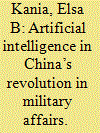

|
|
|
|
|
| Summary/Abstract |
The People’s Liberation Army (PLA) seeks not only to equal but also to overtake the US military through seizing the initiative in the ongoing Revolution in Military Affairs (RMA). Chinese military leaders believe the form of warfare is changing from today’s ‘informatised’ (信息化) warfare to future ‘intelligentised’ (智能化) warfare. The PLA’s approach to leveraging emerging technologies is likely to differ from parallel American initiatives because of its distinct strategic culture, organisational characteristics, and operational requirements. This research examines the evolution of the PLA’s strategic thinking and concepts of operations, seeking to contribute to the military innovation literature by evaluating major theoretical frameworks for the case of China.
|
|
|
|
|
|
|
|
|
|
|
|
|
|
|
|
| 3 |
ID:
182634


|
|
|
|
|
| Summary/Abstract |
China has prioritized quantum science and technology as a critical frontier for its national security and development. To date, Chinese research has already reached a leading position within the discipline, enabled by state support and funding, as well as the recruitment and cultivation of talent. The rapid advances on this front can provide a valuable illustration of the dynamics of China’s evolving innovation ecosystem, including the increased prominence of leading technology companies, and even start-ups, as serious contenders. China’s strategy of military–civil fusion, which aims to create a more integrated ecosystem in science and technology, can contribute to enabling progress in dual-use developments. This case study draws upon the shared framework for this special issue, which provides a method by which to consider the factors that enable defense innovation. Looking forward, these advances could prove consequential for the future strategic balance between China and the United States.
|
|
|
|
|
|
|
|
|
|
|
|
|
|
|
|
| 4 |
ID:
179507
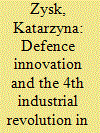

|
|
|
|
|
| Summary/Abstract |
Russia is pursuing select 4th Industrial Revolution (4IR) technologies in a drive to rapidly close the capability gaps with rivals. The transformation of warfare these technologies portend could also make Russia more vulnerable. Joining the ‘technological race’ seems therefore less of a choice than an existential necessity. Constrained by structural problems and lacking the resources of the US and China, however, Russia has so far struggled to leverage its ambitions within the 4IR. Yet it has also shown the ability to experiment with 4IR technologies, including hypersonics and AI, to amplify existing symmetric and asymmetric capabilities, and create interconnected systems that may provide critical advantages.
|
|
|
|
|
|
|
|
|
|
|
|
|
|
|
|
| 5 |
ID:
192531
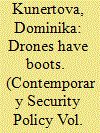

|
|
|
|
|
| Summary/Abstract |
Before Russia’s 2022 invasion of Ukraine, security studies scholars were myopic about small drones’ enabling functions and tactical benefits. They were preoccupied with drone impacts on international security and the ethical dimensions of counterterrorism drone strikes. Similarly, literature on the revolution in military affairs has examined emerging drone technologies based on their strategic advantages. “Low-tech” drone innovations have received less attention. The war has highlighted the collective magnitude of these omissions. At first, scholars followed extant predictions by concluding that large drones did not revolutionize warfare, proliferated slowly, and were too costly and complex to operate. Yet, one year into the war, thousands of drones—scouts, loitering grenades, drone bomblets, and suicide drones—are defying the field’s assumptions of their uselessness sans air superiority. Contrary to most theoretical expectations, small drones in Ukraine are changing battlefield dynamics from lower airspace. Scholars must begin to study drone diversity in modern wars.
|
|
|
|
|
|
|
|
|
|
|
|
|
|
|
|
| 6 |
ID:
128724
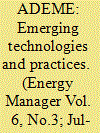

|
|
|
| 7 |
ID:
167672
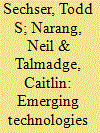

|
|
|
|
|
| Summary/Abstract |
Recent commentary has sounded the alarm about the effects of emerging technologies on strategic stability, yet the topic has received relatively little systematic scholarly attention. Will emerging technologies such as cyber, autonomous weapons, additive manufacturing, hypersonic vehicles, and remote sensing make the world more dangerous? Or is pessimism unwarranted? In this volume, we leverage international relations scholarship, historical data, and a variety of methodological approaches to discern the future implications of new technologies for international security. The findings suggest that new technologies can have multiple, conditional, and even contradictory effects on different aspects of strategic stability, and raise a host of important questions for future research.
|
|
|
|
|
|
|
|
|
|
|
|
|
|
|
|
| 8 |
ID:
174236


|
|
|
|
|
| Summary/Abstract |
As part of a nuclear security summit in 2016, fifty world leaders participated in a crisis simulation of a radiological terrorist attack. According to the scenario, the radiological material was stolen from a hospital and sold via the Dark Web to a terrorist group that delivered it using a drone against a civilian target. 1 The scenario, while fictional, was firmly rooted in technological developments that present a new range of challenges to preventing non-state actors from acquiring and using chemical, biological, radiological, and nuclear (CBRN) weapons.
|
|
|
|
|
|
|
|
|
|
|
|
|
|
|
|
| 9 |
ID:
167678
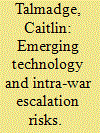

|
|
|
|
|
| Summary/Abstract |
Will emerging technologies increase the risk of conflict escalation? This paper develops a framework for evaluating the role of technology in different types of intra-war escalation. It then uses the framework to probe empirically the possible role of technology in escalation through three carefully chosen cases from Cold War. The findings largely cast doubt on the idea of emerging technologies as an independent, primary driver of otherwise avoidable escalation, suggesting instead that technology more likely functions as an intervening variable – a sometimes necessary, but rarely sufficient, condition for escalation. The conclusion explores the implications of this analysis for the future.
|
|
|
|
|
|
|
|
|
|
|
|
|
|
|
|
| 10 |
ID:
179505
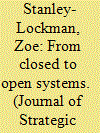

|
|
|
|
|
| Summary/Abstract |
The return to strategic competition affects the US military services differently, but all are contending with the challenge of renewing their military advantage against near-peer, technologically advanced competitors. Commercially driven innovation trends simultaneously challenge the way that the US military manages technology. This article traces the pursuits to institutionalise open innovation practices inside the services to incorporate emerging technologies into their envisaged competitive advantage. Rather than treating the US military as a monolithic entity, this article assesses how new service-level organisations differ in the ways and means they pursue innovation and seeks to explain why those differences persist.
|
|
|
|
|
|
|
|
|
|
|
|
|
|
|
|
| 11 |
ID:
167673


|
|
|
|
|
| Summary/Abstract |
We ask how the offense-defense balance scales, meaning how it changes as investments into a conflict increase. To do so we offer a general formalization of the offense-defense balance in terms of contest success functions. Simple models of ground invasions and cyberattacks that exploit software vulnerabilities suggest that, in both cases, growth in investments will favor offense when investment levels are sufficiently low and favor defense when they are sufficiently high. We refer to this phenomenon as offensive-then-defensive scaling or OD-scaling. Such scaling effects may help us understand the security implications of applications of artificial intelligence that in essence scale up existing capabilities.
|
|
|
|
|
|
|
|
|
|
|
|
|
|
|
|
| 12 |
ID:
187497


|
|
|
|
|
| Summary/Abstract |
Nonproliferation systems comprise agreements designed to work in concert to manage specific security risks. New technologies, however, are exacerbating these risks by perforating controls and evading regulations while revealing limitations in the utility of these tools for managing threats from emerging dual-use technologies. This article first looks at how regime augmentation and control-list modernization have worked as solutions to past challenges for nonproliferation systems. Second, it argues that new drivers of this risk are creating near-unmanageable conditions. These drivers include the increased rate of production of novel technologies; the digital format of newer technologies, as well as the digitization of existing weapons technologies, platforms, and systems; and the diffusion and latency these drivers facilitate. Finally, the article assesses the feasibility of control-list modernization as a solution to risks posed by rapidly emerging and evolving dual-use technologies today. It argues that nonproliferation efforts should endeavor to preserve the control systems currently in place while simultaneously pursuing complementary measures to mitigate the effects of the digital diffusion of dual-use technologies.
|
|
|
|
|
|
|
|
|
|
|
|
|
|
|
|
| 13 |
ID:
171177


|
|
|
|
|
| Summary/Abstract |
The International Atomic Energy Agency (IAEA) faces challenges in fulfilling its safeguards mandate as a result of an expanding safeguards burden and a relatively static budget. This dilemma has been exacerbated by the additional burdens of implementing the Joint Comprehensive Plan of Action (JCPOA) in Iran, but would not go away if implementation of the JCPOA were to end. There are three main areas of opportunity for the Agency: (1) budgetary expansion tied to changes in staffing policies, (2) changes in safeguards approaches, and (3) technological innovation. Barriers and limitations are associated with each approach, and advancing any of them will face a difficult political environment in Vienna.
|
|
|
|
|
|
|
|
|
|
|
|
|
|
|
|
| 14 |
ID:
186087


|
|
|
|
|
| Summary/Abstract |
In the early 1970s, Moscow and Washington had established a satellite verification regime to monitor arms control treaty compliance. Satellites had become a primary source of transparency and stability in superpower relations. Yet by the end of the 1970s, both the United States and the USSR were developing anti-satellite (ASAT) weapons that could destroy observation satellites. This article uses recently declassified archival documents to show that Jimmy Carter pushed for ASAT limits due to his broader arms control agenda, whereas Ronald Reagan rejected ASAT arms control primarily because of its potential impact on the Strategic Defense Initiative.
|
|
|
|
|
|
|
|
|
|
|
|
|
|
|
|
| 15 |
ID:
128725


|
|
|
| 16 |
ID:
188146


|
|
|
|
|
| Summary/Abstract |
In recent decades, governments have been ineffectual at regulating dangerous emerging technologies like lethal autonomous weapons and synthetic biology. In today’s era of great power competition, changing course is difficult but imperative. Four areas of technological development illustrate the generic problem of responding to innovation: the complexity of the analysis required to determine the best governance responses, the difficulties of building a consensus for action, and the urgent need for institutional frameworks that facilitate anticipatory rather than reactive regulation. The international community needs new, standing international governance frameworks to address this growing challenge.
|
|
|
|
|
|
|
|
|
|
|
|
|
|
|
|
| 17 |
ID:
179504
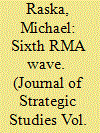

|
|
|
|
|
| Summary/Abstract |
The Revolution in Military Affairs, its concepts, processes, and debates, have evolved in five ‘IT-RMA waves’ since the 1980s. None of them, however, have fully achieved their intended outcomes as their ambitious premises have exceeded available technologies, budgetary resources, and operational capabilities of a given era. This paper argues that a new ‘artificial intelligence-driven RMA’ wave differs in the political, strategic, technological, and operational diffusion paths and patterns. While the AI-RMA may affect select countries and regions disproportionately, its technological advances coupled with an ongoing strategic competition is sufficiently broad to stipulate significant military changes across geopolitical lines.
|
|
|
|
|
|
|
|
|
|
|
|
|
|
|
|
| 18 |
ID:
151060


|
|
|
|
|
| Publication |
New Delhi, KW Publishers Pvt Ltd, 2017.
|
| Description |
xii, 272p.hbk
|
| Standard Number |
9789386288356
|
|
|
|
|
|
|
|
|
|
|
|
Copies: C:1/I:0,R:0,Q:0
Circulation
| Accession# | Call# | Current Location | Status | Policy | Location |
| 058952 | 358.80954/BHA 058952 | Main | On Shelf | General | |
|
|
|
|
| 19 |
ID:
190955
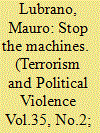

|
|
|
|
|
| Summary/Abstract |
The Fourth Industrial Revolution promises to transform contemporary societies. Similarly, emerging technologies are affording countless new applications that assure an overall and widespread improvement of living standards. At the same time, their potential misuse has sparked concerns. In particular, the possibility of terrorist organizations adopting such technologies has dominated the scholarly debate. Consequently, there is a growing literature that deals with the motivational and technical factors potentially underlying the malevolent resort to emerging technologies. Enthusiasm for emerging technologies is, however, only one side of the coin. The last decade has, indeed, witnessed a re-emergence of forms of Neo-Luddism. Nevertheless, a thorough understanding of these developments is still lacking. This paper investigates and maps the main debates and dynamics in the Anti-Technology Movement in order to understand the rationale behind—and the prospects of—this resurgence. In doing so, it focuses on two radical fringes, namely the Insurrectionary Anarchist Milieu and the Radical Environmentalist Milieu. The paper argues that, although based on different narratives and end goals, these milieus share a similar commitment and operational approaches as well as a marked apocalyptic millenarian thinking that has set them on an escalatory path.
|
|
|
|
|
|
|
|
|
|
|
|
|
|
|
|
| 20 |
ID:
190071


|
|
|
|
|
| Summary/Abstract |
Innovations in technologies coupled with evolving military thinking have led to advanced emerging military technologies ranging from artificial intelligence, lethal autonomous weapons, hypersonic weapons, directed energy weapons, biotechnology, and quantum technology. These technologies not only open new domains in warfighting capabilities and strategy by changing the size and speed of destructions but may also bring challenges in curbing arms race, managing networks, and achieving peace and security. This study examines the rising significance of emerging technologies in Indo-Pacific security and further explores US strategies for building, dominating, and managing the different networks of technologies, domains, command and control (C2), alliances, and partners. As advanced technologies play a critical role in supporting national strategic goals, as in the case of China, it seems clear that the future of strategic competition will be dictated by who builds, dominates, and manages these networks and how one does it most effectively with clear strategic vision. In this paper I argue that networks are crucial in understanding emerging technologies and Indo-Pacific strategy for the unfolding era of strategic competition.
|
|
|
|
|
|
|
|
|
|
|
|
|
|
|
|
|
|
|
|
|